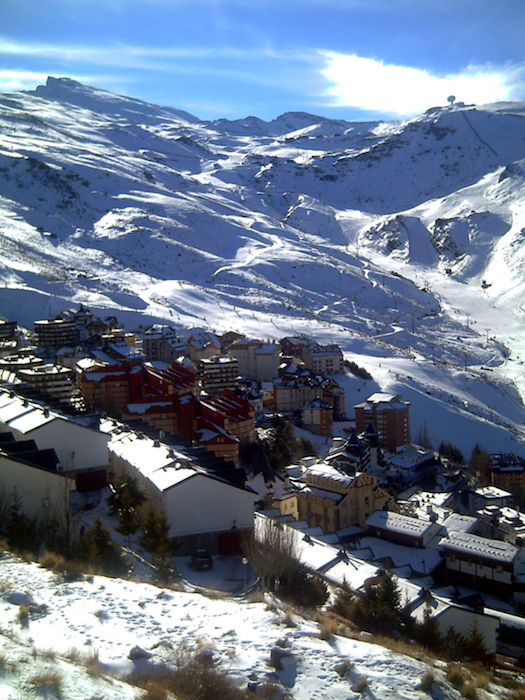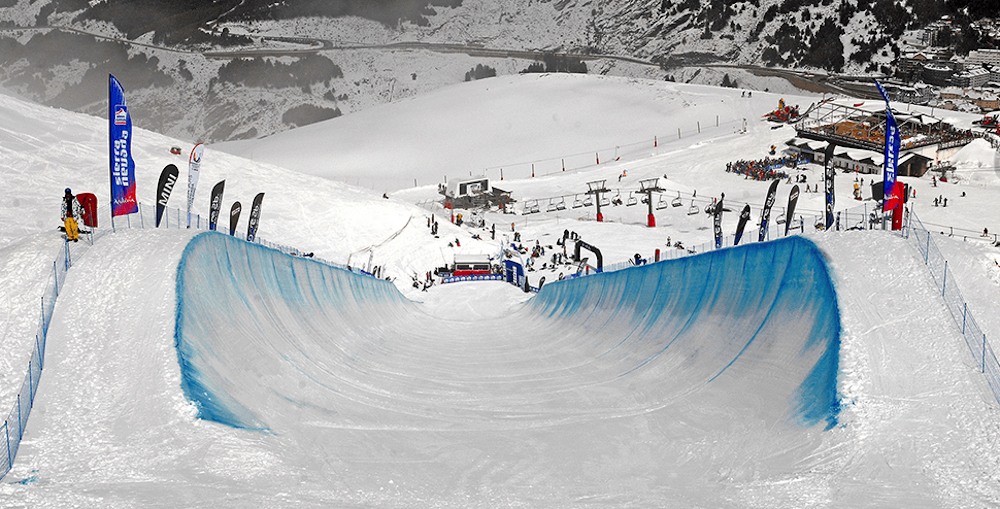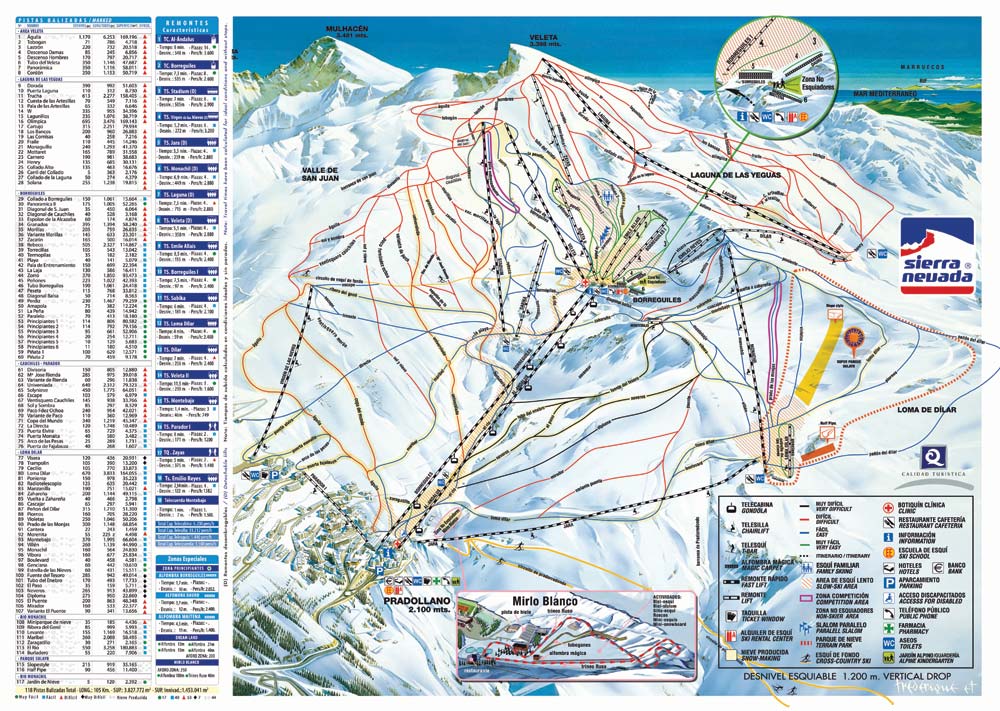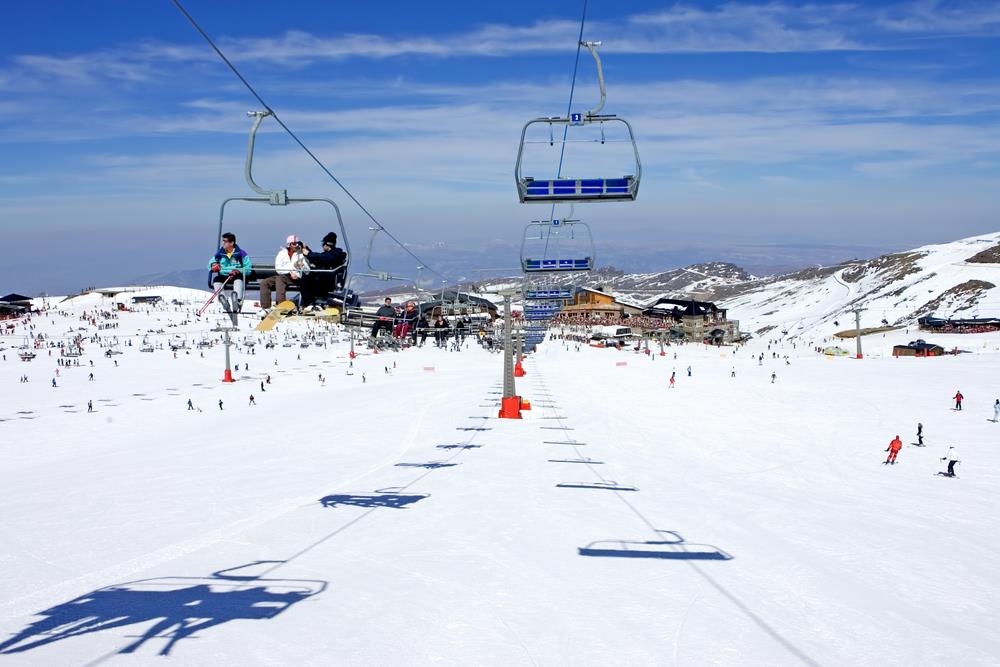
Founded in 1964, the Sierra Nevada resort defies many concepts associated with skiing. Located barely a stone's throw from the Mediterranean coast, it has practically guaranteed sunshine, the best Spring snow conditions in Europe, and is reasonably priced compared to many of its European counterparts.
The ski area is on the northwestern slopes of Veleta, the third highest peak in peninsular Spain and the most southerly ski resort of Europe. It is close to the Mankind Heritage City of Granada, only 32km away. Also, the resort is only 90 minutes away from the Mediterranean Sea.
The resort hosted the FIS Alpine World Ski Championships in 1996 and occasionally hosts World Cup races. The last were women's technical races in 2007. In recent years World Slope and Freestyle events have made a very successful appearance here. It was also host to the 2015 Winter Universiade, the world university games. In March 2017, Sierra Nevada hosted the FIS Freestyle Ski and Snowboarding World Championships 2017.
At the foot of the slopes there is a resort village, Pradollano, which stretches up a mountain to the north of the pistes.
Pradollano, at 2,100m, is the stylish modern lift base, with shops, restaurants and bars set around traffic-free open spaces. The accommodation sits around the winding road leading up the mountain side from the base at Pradollano.
The resort boasts over 100km of slopes spread across 124 runs. The vertical is 1,200m, from the Pradollano base at 2,100m up to the higher lifts on El Veleta at 3,300m. As if the altitude of the area is not enough the resort also provides 35km of snowmaking on 44 slopes. Two gondolas go up in parallel to the mid-station at Borreguiles, where there are excellent nursery slopes offering a welcoming and fun place for youngsters to get into skiing. At Borreguiles there are a few cafés and restaurants, a ski school, a few hire shops and lockers. Fast quads go on from there to an impressive 3,300m. There are four identifiable sectors, well linked, with a good range of intermediate runs, mostly easy reds, but not a lot for experts.
The resort has made some significant developments in recent seasons regarding their freestyle terrain. At the Sulayr Terrain Park there's something for everyone, including the longest slopestyle slope in Europe as well as the biggest permanent half-pipe in Spain.
The resort opens the Loma de Dilar area early on Sundays so from 7.30am to 9am, prior to the general opening hours, you can enjoy blissfully quiet slopes. Night skiing is offered on the Rio and Maribel slopes on Saturdays and Tuesdays.
Snow here may be good when it's poor in the Alps, and vice versa, but the investment in snow making can really help things if needed. Most slopes face north-west, but some get the afternoon sun. And when the wind blows, as it can do, the slopes can close.
The Ski Season & Environment
As one of Europe's highest resorts it is very snowsure and typically has a long season. Traditionally the season starts around the end of November running through to the first week of May. The longest season on record was the winter of 2008/9 which ran from the 15th November 2008 until the 17th May 2009.
Sierra Nevada literally means "Snowy Mountain Range" and it includes some of the highest peaks in Europe, not to mention the highest concentration of peaks over 3,000m in the country. The Mulhacén at 3,482m is the Iberian Peninsula's highest.
The ski terrain is majestically overlooked by the jagged glacier-formed Veleta peak at 3,398m, Spain's third highest after Aneto (3,404m) in the Pyrenees. Due to the altitude, the ski slopes are above the tree line and generally take the form of ski fields rather than narrow prepared tracks - something that favours the more nervous skier in particular as well as generally giving a sense of confidence all round, especially for off piste fanatics!
The Sierra Nevada ski resort offers its visitors a wide and ever expanding range of facilities as well as a ski terrain to suit skiers and boarders of all standards.
Families
Families will enjoy quality children's facilities such as the Mirlo Blanco recreation zone, with activities including Ski Bike, Inner Tubing, Ice Skating and a "Roller-Sled" (a cross between a roller-coaster and bob-sled).
The ski terrain has designated "Family" zones which are patrolled from time to time to ensure better ski sense. The development of the "Pista del Mar" offers a novel themed slopeline from the chairlift up to the ski slope down where numerous objects and animal figurines related to the sea are located to give kids a fun experience in their skiing. At weekends, obstacle courses are created to enhance even further your child's experience.
The Crèche and Dreamland Snow Garden are well-run establishments with fully trained staff to look after children up to six years old. Pre-booking is recommended.
Ski Equipment Hire
Getting kitted out and ready for the slopes is made easy at Rio Sport Intersport equipment-hire shop, where you will find quality rental equipment and a knowledgeable team of English speaking staff to sort you out with the right equipment according to your standard.
Beware of street sellers offering low priced equipment hire - the equipment can be poorly maintained and the sellers are rarely knowledgeable.
The British Ski Center is also based at Rio Sport, for any tuition or guiding requirements you may have. Ask directly for the British Ski Center to avoid confusion with the shop's own Spanish Ski School.
Climate & Snow
An important factor, which very few resorts can boast, is that you are practically guaranteed sunshine throughout your stay! Being so far south, the climate is superb for brushing-up on the deepest ski tan you are likely to get anywhere! Visitors are consistently stunned at how the snow lasts during the typically deep-blue-skied, sun-blazoned days.
Much of this is due to the resort organisers working extremely hard at preparing the runs each and every night. By packing the snow down, even the shallowest of snow bases may be maintained for several weeks even if it does not snow for prolonged periods. In addition to this, the resort is equipped with one of the most advanced snow making systems in existence. So that even in the theoretical situation that not so much as a single flake of snow has fallen (which has never happened) the resort organisers still guarantee skiing! This has been proven over the winters of 2005/6, 2006/7 and 2007/8, three seasons where early snowfall was especially limited.
The winter of 2014/15 was in general Europe's worst start for between 25-40 years depending on the resort. Indeed a high percentage of resorts were unfortunate enough to be unable to open until well into January. Sierra Nevada was fortunate enough to have received some good snow in early November before the drought hit. As a result of its altitude and dry climate, temperatures and humidity levels were such that an impressive snow making campaign was put into action from the first day of the season, 29th November 2014, and throughout the month of December, the Christmas festivities and even into January before the next significant snowfalls came. The result of this was not only was there skiing from the end of November but they had all ski areas open and hence catered for all skiers/boarders and avoided significant queues at busy times. The altitude and climate is something quite unique to Sierra Nevada compared to lower lying and more humid European resorts.
Sierra Nevada proved its worth in this manner also in 2006/7 and was officially the first resort to open in Europe (except for the Alpine glacier resorts).
Be Prepared
In spite of the sunshine, bad weather is to be expected of course so be sure to pack sensible clothing and be prepared. The ski terrain in Sierra Nevada is open and very exposed should conditions change, and they can change extremely quickly!
When the snow and weather are favourable however, the openness of the ski terrain provides some of the most exhilarating free skiing/riding to be found anywhere.
Off Piste
Off-piste skiing in Sierra Nevada has made a great name for itself. The open expanses lend themselves to finding easily accessible areas all over the terrain with very little avalanche risk by European comparisons.
It is also something that inexperienced "off-piste skiers" love for the simple fact of minimum risk by not having to take a hike to find good sections for learning on!
Note: Injuries occurring while skiing off piste are not covered by the lift pass insurance cover.
Resort facts:
Resort base level: 2100 m
Top Station: 3300 m (Veleta peak 3,398m)
Vertical Drop: 1200 m
Slope Orientation: NW & W
Groomed Surface: 380,00 ha
Length of marked slopes: 106,8 km
Total of runs: 125
Green Runs -Very easy: 19
Blue Runs - Easy: 42
Red Runs - difficult: 50
Black Runs - Very difficult: 7
Snowpark runs: 7
Longest run: El Águila - 6,253 Km
Snow making: 350 canons
Snow making: 44 runs 35 Km of piste (145 Ha)
Number of Lifts: 21
Gondolas: 2 Detachables
Chairlifts: 14 6 Detachables
Ski lifts: 1
Conveyor - Carpet lifts: 4
Total Lifts Capacity: 45,207 skiers per hour
Special areas:
- Recreation Area Mirlo Blanco 1 conveyor belt and 1 Mountain coaster
- Dream Land - Snow Playground with 3 Conveyor belts
- Freestyle Park Sulayr, Loma de Dílar Area: 1x 165m long half-pipe, 1 Mini Park, Medium and Advanced Difficulty Areas covering 4 interlinked sectors complete with a full range of jumps & rails plus a small lift and Europe's longest slopestyle run with the possibility of linking up to 46 different modules in one run.
- Slides for pneumatic displacement-Tubing- (2 belts)
Crèche services: 1 Snow garden in Borreguiles and 1 crèche in Pradollano
Snowboard and ski teachers: 400
Ski schools: 15
Car parking: Total of 4007 parking spaces of which 2644 are underground.
Download a map of the ski runs, a .pdf (3.6MB): http://sierranevada.es/en/winter/the-ski-resort/on-ski-slopes/
Useful websites:




